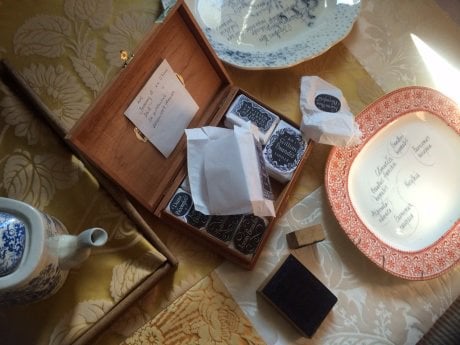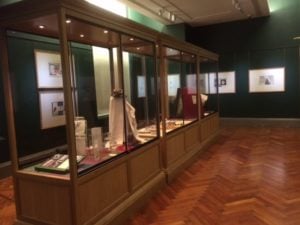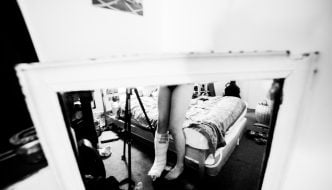Emma Gregory’s Semi Permanent Collections @ Liverpool’s Victoria Gallery & Museum
August 26, 2016

Photo Credit – Liverpool Victoria Gallery & Museum
In a line down the centre of a low-lit, sombre chamber lies a body of work encased in glass cabinets, surrounded by prints at head height gently hung on the walls. Emma Gregory, a Fine Art graduate from the Central School of Art and Design, began her project drawing in Liverpool University’s heritage collections store. The exhibition titled Semi Permanent Collections initially focused on the struggles associated with organic specimens and their preservation.
The cabinets positioned in the centre of the space creates an annulus around which the viewer must walk. For the onlooker, this is significant as the curatorial platform reflects the cyclical structure of life. While the production of the exhibition alludes to the circle of life, the majority of its intents focus on expiration, preservation and the grey area that follows. While drawing in what she describes as a ‘cold concrete bunker’ Gregory’s work began to develop in a more personal direction when her father became ill.
Gregory’s set of four laser cut drawings document the process of her father’s dwindling life at a hospice. She identified her attraction to organic forms and their “possible histories”, although “repulsed by the proximity of so much death” as a result of being surrounded by fauna specimens in the university collection store. This, combined with the stress of her father’s illness led to her infatuation with preservation. While Gregory labels the piece the “full-stop” of the show, I feel that by documenting this compellingly despairing reality, she opens up a riveting world of enigma and continuity that leaves the audience in a state of introspection. Present in the drawings is an owl, which for Gregory works on a metaphorical level, representative of his existence. It has to be noted that the size of the owl increases throughout the process that she documents so vividly and is distinctly suggestive of the conundrum that is the afterlife.
Gregory also draws on the idea of family history and repeatedly returns to the notion of inheritance. She manifests her yearn to preserve her family’s legacy by warping her grandmother’s timeless artefacts into the exhibition. Diana Bloomfield, Gregory’s grandmother (also an artist), produced intricately designed buttons, postcards, and letterpress blocks all of which we get a glimpse of in the exhibition. Gregory’s large, wall mounted prints made from her grandmother’s wood engraving blocks are presented in the form of a family tree. This not only aesthetically enhances the minimalistic prints but alludes to the imprinting of memory, imbuing an aura of remembrance. While Gregory utilises the memorabilia of her predecessors, she transforms the relics to make the work her own. By revitalising her grandmother’s work, Gregory alludes to the concept behind the exhibition as a whole, which combines both print making and archive in a visual timeline, delicately placed in a ‘cabinet of curiosities’ as a means of demonstrating her enchantment with inheritance and maintenance.

Photo Credit: Emma Gregory
One piece in the exhibition that visually emotes Gregory’s hope for her family’s remembrance is the collaborative mixed media piece that she made with her daughter. Gregory crafted a portrait of her daughter as an infant using a collection of old family buttons which she then photographed, printing it onto paper. Layered on top of the photograph is an egg like formation created by Gregory’s daughter; made up of paper, leaves, glue stains and graphite markings. Crucial for the observer is the egg-like structure. An egg, symbolic of new life is used here as a visual depiction of the continuity Gregory so desperately seeks to document and treasure through her work. By having aspects of art and nature coexist in the piece she juxtaposes nature’s unpleasant reality of life’s inevitability and the beautiful subsistence of art that spans several generations in her family.
Patrick Kirk-Smith sees Gregory’s exhibition as an “autobiographical” show and explains how “the element of value is freeingly forgotten” as a result of the work being aimed at “record-keeping”. Smith makes a valid point regarding the artist’s personal connection to the work and aptly addresses Gregory’s desire to keep family records. That said, I would argue that as a viewer we do not freely disregard all value. This is mainly due to the fact that the exhibition requires too much of a one to one experience between art and observer. While Smith sees the work as a visual autobiography that distances the art from the viewer, I infer that Gregory invites the viewer to interpret her experiences through the visual timeline she crafted and respond according to their own personal experiences.
Gregory wholeheartedly confronts mortality and attempts to present a mediation for the ephemeral essence of existence through art, using inheritance as inspiration to create work in response to the irrepressible reality of life’s inevitability.
Semi Permanent Collections has been extended and runs until 15th October 2016.
Filed under: Art & Photography
Tagged with: art, Emma Gregory, exhibition, Semi Permanent Collections, Victoria Gallery & Museum



Comments